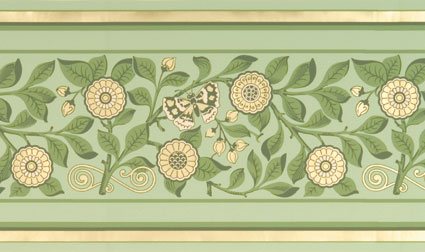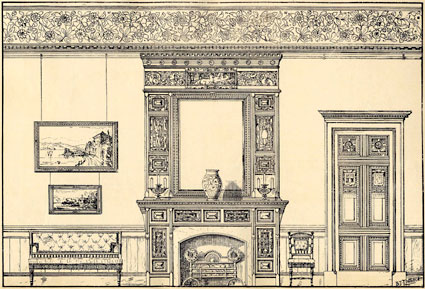



Uncovering the history
of this exquisite design began with finding a sample of the wallpaper frieze
in the British Patent Office and eventually led to revealing the identity
of the designer.
The room in the photograph is a superb example of an Aesthetic Movement interior. It contains many of the iconic elements which characterized the decorating style: tasteful wallpaper, abundant displays of china and simplified furniture forms, with a sprinkling of the Orient throughout the room - all assembled and arranged to signal that the occupants had an artistic flair and were current in their taste.
But what of the wallpapers used in the room? Closer examination of the photograph shows the wall fill to be "Jasmine," a design William Morris registered in 1872. Although the Liverpool frieze is an excellent complement for the wallpaper, it is not a Morris design. The patent office records the frieze as "English Style," having been registered in June of 1870 by Gillow of Lancaster & London, a specialist furnisher catering to the upper classes. While the designer is not credited on the patent, it is stylistically similar to known wallpaper patterns by Bruce J. Talbert printed by Jeffrey and Co. Talbert created furniture for Gillow; could Gillow have contracted Talbert to design this frieze? Talbert's association with Gillow is intriguing, but not strong enough evidence to definitely credit Talbert with the design of this beautiful frieze of flowing leaves, flowers, and butterflies. For now, the designer would have to remain anonymous.

At left, a Liverpool interior, c. 1880.
Image © National Museums Liverpool.
Although I was still curious about the designer, it seemed I had reached a dead-end for uncovering any more clues about this wallpaper frieze. Happenstance found me thumbing through a bound set of the The Cabinet Maker and Art Furnisher journal in a small shop, about an hour away from home. The Cabinet Maker and Art Furnisher was a London trade journal that began publication in 1880. Profusely illustrated, it was one of the periodicals that commemorated Talbert after his death by printing a series of his designs. Flipping through pages of the thick volume provided one visual treat after another. I wasn't looking for anything in particular, just absorbing the panorama of late century design and thoroughly enjoying the confluence of art and commerce on the old, yellowed pages. Talbert was well represented by furniture design after furniture design and one room design after another. As I was giving a cursory examination to one page, something caught my eye. Eureka! Before me was a sketch for a room design by Bruce Talbert with the patent office/Liverpool frieze running prominently across the top of the wall. The description of that Talbert sketch in the August 1, 1881 issue is as follows:

Mason and Wolf Wallpaper :: PO Box 6224 :: Freehold,
NJ 07728
phone 732-866-0451 :: fax 732-866-4264 :: info@mason-wolf.com
All site contents © Copyright 2005-2019 Mason and Wolf Wallpaper :: All rights reserved.